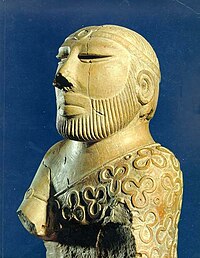Cities
A sophisticated and technologically advanced urban culture is evident in the Indus Valley Civilization making them the first urban centers in the region. The quality of municipaltown planning suggests the knowledge of urban planning and efficient municipal governments which placed a high priority on hygiene, or, alternately, accessibility to the means of religious ritual.
As seen in Harappa, Mohenjo-daro and the recently partially excavated Rakhigarhi, this urban plan included the world's first known urban sanitation systems. Within the city, individual homes or groups of homes obtained water from wells. From a room that appears to have been set aside for bathing, waste water was directed to covered drains, which lined the major streets. Houses opened only to inner courtyards and smaller lanes. The house-building in some villages in the region still resembles in some respects the house-building of the Harappans.[35]
The ancient Indus systems of sewerage and drainage that were developed and used in cities throughout the Indus region were far more advanced than any found in contemporary urban sites in the Middle East and even more efficient than those in many areas of Pakistan and India today. The advanced architecture of the Harappans is shown by their impressive dockyards, granaries, warehouses, brick platforms and protective walls. The massive walls of Indus cities most likely protected the Harappans from floods and may have dissuaded military conflicts

No comments:
Post a Comment